Climate change, urbanization, and low-quality drainage systems lead to frequent urban waterlogging and serious water pollution in China. Urban water problems are one of the bottlenecks limiting the sustainable development of Chinese cities. To alleviate the urban waterlogging problem, China proposed a sustainable urban stormwater management concept: Sponge City, and started to conduct sponge city pilots across the country in 2015.
To study the decision-making procedure of Sponge City, Yingran Li (M.A. ’21) looked at actions of various levels of government and other stakeholders in China to participate in the sponge city construction in her 2021 master’s thesis at Tufts Urban & Environmental Policy & Planning through qualitative approaches and empirical evidence. Her thesis has been selected for the UEP Outstanding Thesis Award.
Li’s study demonstrated how the central and local governments promote sponge city construction through policy and planning, pilot sponge cities, financial support, organizational systems, evaluation systems, and how private capital and the public participate in sponge city construction. More specifically, Li took Wuhan, one of the first pilot cities for sponge city construction, as an example to show the detailed progress of sponge city construction. Li also provided some recommendations from the perspective of planners and policymakers at the end based on the problems found in the analysis. Read on below for more details of the study.
Chinese government raised sponge city to deal with water problems including urban waterlogging. How does it promote sponge city construction?
Since 2013, from the central to the local level, the Chinese government has continuously issued sponge city-related policies and plans, enriching the public’s understanding of the concept and disseminating information on the construction plan, implementation guidelines, supervision, and management of sponge cities.
1. National Sponge City Construction
The central government released policies and documents to provide clearer regulations and guidance for the life cycle of sponge city construction. It selected 30 cities as pilot sponge cities and supported them politically and financially. Wuhan was one of them. These pilot cities took the lead to concentratedly construct sponge cities from 2015 to 2017 and were evaluated in 2018. To evaluate the construction effect, the central government issued assessment criteria, mainly from six dimensions: water ecology, water environment, water resources, water security, policy construction and implementation, and percentage of renovated area.
2. Local Sponge City Construction
Local governments took more detailed and enforceable actions based on national policies. Sponge city construction involves many departments, so governments set up an internal collaborative platform. The platform organized the compilation of sponge city special planning, approved sponge facility construction and renovation projects, and supervised and managed their construction and operation.

3. Incorporating Stakeholders and Public Participation
Other stakeholders and the public also play an important role. For example, to relive financial burden, the government promotes private capital to participate in Public-Private-Partnership (PPP) projects. Private capital can participate in the investment and construction of sponge city projects and in the subsequent dividends of the project.
In terms of public participation, residents can raise objections to the planning and project proposals during the public notice period. They can also supervise the projects during the construction and operation and respond to the relevant departments.
More specifically, how does Wuhan, as a pilot sponge city, promote sponge city construction?
1. Developing Sponge City Policy and Planning
Wuhan is a city with frequent flooding, and some of its water bodies are seriously polluted. Therefore, Wuhan’s sponge city planning focuses on solving urban waterlogging and water pollution. It aims to improve the ability to cope with waterlogging by renovating the drainage system, protecting natural water bodies, restoring water channels, improving the efficiency of rainwater treatment and utilization, and upgrading the capacity of pumping stations. In terms of water pollution management, Wuhan focuses on reducing non-point source pollution and end treatment through low-impact development facilities.
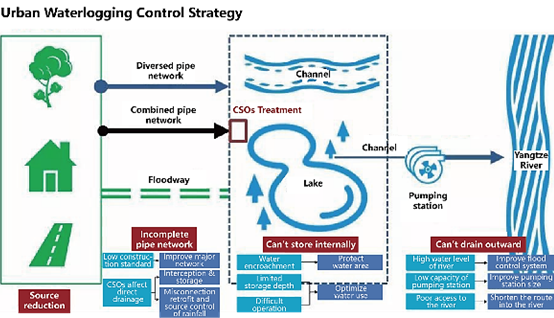
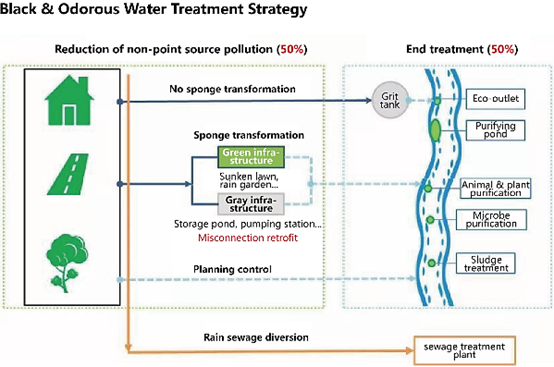
2. Building the Organizational Platform and Raising Funds
Wuhan set up a sponge city construction office in the Water Authority headed by the mayor, containing relevant departments and two state-owned companies. The Wuhan Sponge City Construction Pilot Implementation Plan distributed the responsibilities of each member in the leading group.
During the three-year pilot period, Wuhan raised a total of 16.3 billion yuan for sponge city construction through central financial subsidies, local financial allocations and government and PPP projects.
3. Selecting Demonstration Areas
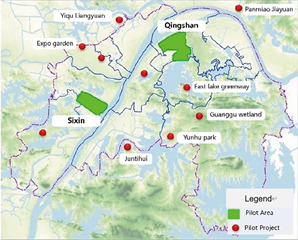
The construction period of the pilot sponge city in Wuhan was from 2015 to 2017. It selected two concentrated demonstration areas, one in the old urban area of Qingshan and another in the new urban area of Sixin, as well as other representative pilot projects, so that it can experiment with sponge city construction in different types of areas.
In the pilot areas, Wuhan adopted various measures to promote the sponge city-related infrastructure construction. One goal was to build Low Impact Development (LID) facilities, such as permeable parking lots, permeable concrete pavements, rain gardens, concave green areas and green roofs in communities and public spaces. Other goals included strengthening of drainage facilities and restoring urban water ecosystems.
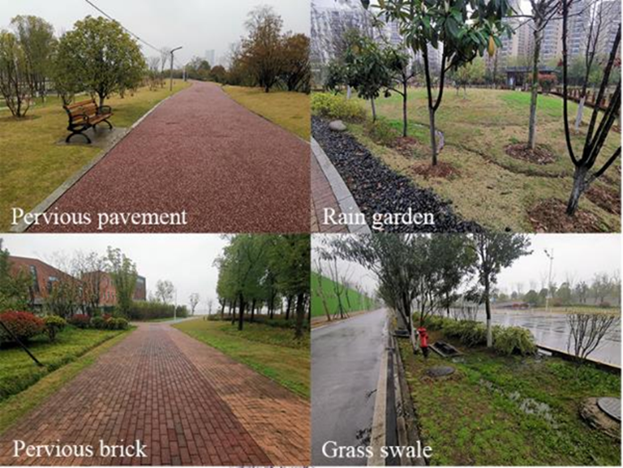
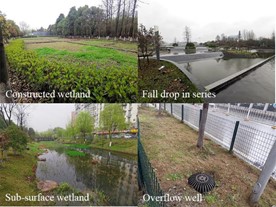
Problems and Recommendation
In July 2020, Wuhan experienced heavy rainfall after the pilot period, it only took 6 hours for almost all of the water to subside. Back in 2016, it took 24 hours for 90% of the water to subside on the main roads, and some seriously affected areas even continued to be waterlogged for a month. From that aspect, we can conclude that Wuhan’s sponge city construction works.
But Wuhan’s sponge city construction still has room for improvement, mainly in the following aspects:
- Outdated planning philosophy: For a long period of time, China’s cities were built according to traditional urban construction models. The governments’ philosophy of “rapid stormwater drainage” has proven to be unsuitable for the current pace of urban development. Although Wuhan is actively promoting the concept of sponge city, changing mindset needs time and joint efforts.
- Incomplete legal system: The pilot cities that have shown good results so far. The promotion of Sponge City is generally led by secretaries and mayors, with personal supervision and questioning. If these practices are adopted as laws, changing implementation from the “rule of man” to the “rule of law,” they would play a beneficial role in promoting and building sponge cities.
- Lack of long-term government management mechanism: Some policies only stay at the macro level, with insufficient details, and the follow-up operation and supervision mechanism are not perfect. The infrastructure design standards related to sponge facilities have not been updated. The government also faces funding gaps, lack of communication and cooperation between departments, and lack of professional training and technology. All these will affect the long-term promotion of sponge cities.
- Insufficient public participation: Most of the current public participation methods are top-down and do not fully mobilize residents’ enthusiasm. Meanwhile, many citizens don’t know much about Sponge City, which leave them unable to participate in decision-making process.
In response to these problems, the thesis concludes with some strategies.
The government’s planning philosophy should be changed to emphasize the underground construction, the operation and management of the project, and the long-term benefits. To promote public participation, stakeholders can strengthen the publicity of sponge cities through various activities and media to enhance public understanding of sponge cities. Government can also learn from the community planner system of western countries like the United States, let the planners go into the community to collect residents’ opinions.
Finally, in terms of government governance, there is room for policy optimization in all aspects. For example, establishing a legal system for sponge city planning at the national and local levels; improving the cooperation mechanism of various departments; improving fiscal and taxation policies, financing policies and establishing a market-based management mechanism; improving the recruitment, hiring and training of SCC staff; and optimizing the assessment system and the supervision mechanism.
Learn more about UEP’s Outstanding Thesis Award and other winning theses from AY2021 here. See the Exemplary Thesis Library for more.